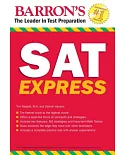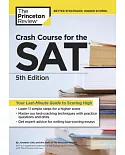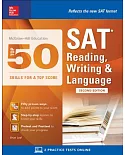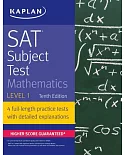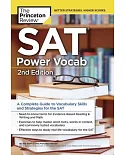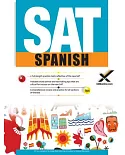Master the SAT II French Subject Test and score higher... Our test experts show you the right way to prepare for this important college exam. REA's SAT II French Subject test prep covers all
French language areas to appear on the actual exam including in-depth coverage of declensions, verb tenses, spelling pitfalls, negation, and more. The book features 6 full-length practice SAT
II French exams. Each practice exam question is fully explained to help you better understand the subject material. Use the book's glossary for speedy look-ups and smarter searches.
Follow up your study with REA's proven test-taking strategies, powerhouse drills and study schedule that get you ready for test day.
DETAILS
- Comprehensive review of every French language topic to appear on the SAT II subject test
- Flexible study schedule tailored to your needs
- Packed with proven test tips, strategies and advice to help you master the test
- 6 full-length practice SAT II French Subject exams: each exam question is answered in complete detail with easy-to-follow, easy-to-grasp explanations
- The book's glossary allows for quicker, smarter searches of the information you need most
TABLE OF CONTENTS
About Research & Education Association
Study Schedule
Passing the SAT II: French subject test
About this Book
About the Test
How to Use this Book
Format of the SAT II: French Subject Test
About the Review Sections
Scoring the SAT II: French Subject Test
Studying for the SAT II: French Subject Test
Test-Taking Tips
Score Conversion Chart
Chapter 1
The Sounds of French
Pronunciation Hints
The International Phonetic Alphabet (IPA)
The French Alphabet
Accents
Liaison
Elision
Syllabification
Chapter 2
Cognates - Words You Recognize
Cognates Common to Both Languages
Cognates with Minor Spelling Changes
Spelling Pitfalls
"Faux amis" (False Friends)
Some Borrowed Words
Capitalization
Interrogative Sentences
Chapter 3
By the Numbers
Counting from 1 to 1,000,000,000
Telling Time
Describing Time
Days of the Week
Months
The Four Seasons: Les quatre saisons
Expressing the Year
Phone Numbers
Expressing Age
Calculations
Comparisons
Ordinal Numbers
Chapter 4
Nouns and Articles
Gender
Formation of Feminine
Plural Nouns
The Article
Special Uses of the Definite Article
The Indefinite Article
Chapter 5
The Partitive Article (Le Partitif)
General Use
Formation
Omission of the Definite Article after "de"
Definite, Indefinite, or Partitive Article
Chapter 6
Adjectives
Function
Formation of Feminine
Position of Adjectives
Comparing with Adjectives
Possessive Adjectives
Demonstrative Adjectives ("this," "these")
Interrogative Adjectives
Adjectives of Number
Demi(e): Half
Indefinite Adjectives
Chapter 7
Pronouns
Subject Pronouns
Direct Object Pronouns
Indirect Object Pronouns
With Two Verbs Together
With Two Object Pronouns Together
Y and en; penser ��; parler de
Interrogative Sentences with Pronouns
Disjunctive Pronouns
Relative Pronouns
Possessive Pronouns
Chapter 8
Verbs
L'indicatif
L'imp��atif
Le pass��compos��
L'imparfait
Le plus-que-parfait
Le futur proche
Le futur
Le conditionnel
L'infinitif
Le participe pr��ent
Les verbes pronominaux
Two Other Past Tenses of the Indicative
Chapter 9
The Subjunctive
Formation: Regular Verbs
Uses of the Subjunctive in Subordinate Clauses
Uses of Subjunctive after Certain Conjunctions
Le pass��du subjonctif
Chapter 10
Adverbs
Formation of Adverbs
Irregular Forms
Placement of the Adverb
Comparative of Adverbs
The Superlative
Some Common Adverbs
Interrogative Adverbs
Adverbs that Connect Nouns, Phrases, and Clauses
Chapter 11
Prepositions and Conjunctions
Prepositions
Compound Prepositions
Prepositions with Geographic Names
Common Verbs + Preposition + Infinitive
Conjunctions
Chapter 12
Basic Idiomatic Expressions
Expressions with avoir
Expressions with faire
Impersonal Expressions with il
Idiomatic Expressions with �tre
The Verb manquer
Measuring Time with depuis/depuis que
Conna�tre and savoir
Miscellaneous Expressions
Chapter 13
Negation
Positive and Negative Adverbial Expressions
Quelque chose de/rien de + Adjective
Chapter 14
Useful Vocabulary
School (L'��ole)
Animals (Un animal; Les animaux)
The Body (Le corps)
The City (La ville)
Clothing (Les v�tements)
Colors (Les couleurs)
Drinks (Les boissons)
The Family (La famille)
Foods (Les aliments)
Illnesses (Les maladies)
Professions, Occupations (Les professions, les m��iers)
Sports/Leisure (Les sports et les passe-temps)
Countries (Les pays)
Professions (Les professions)
PRACTICE TEST I
Answer Key
Detailed Explanations of Answers
PRACTICE TEST II
Answer Key
Detailed Explanations of Answers
PRACTICE TEST III
Answer Key
Detailed Explanations of Answers
PRACTICE TEST IV
Answer Key
Detailed Explanations of Answers
PRACTICE TEST V
Answer Key
Detailed Explanations of Answers
PRACTICE TEST VI
Answer Key
Detailed Explanations of Answers
Answer Sheets
GLOSSARY
EXCERPT
About Research & Education Association
Research & Education Association (REA) is an organization of educators, scientists, and engineers specializing in various academic fields. Founded in 1959 with the purpose of
disseminating the most recently developed scientific information to groups in industry, government, high schools, and universities, REA has since become a successful and highly respected
publisher of study aids, test preps, handbooks, and reference works.
REA's Test Preparation series includes study guides for all academic levels in almost all disciplines. Research & Education Association publishes test preps for students who have not yet
completed high school, as well as high school students preparing to enter college. Students from countries around the world seeking to attend college in the United States will find the
assistance they need in REA's publications. For college students seeking advanced degrees, REA publishes test preps for many major graduate school admission examinations in a wide variety of
disciplines, including engineering, law, and medicine. Students at every level, in every field, with every ambition can find what they are looking for among REA's publications.
While most test preparation books present practice tests that bear little resemblance to the actual exams, REA's series presents tests that accurately depict the official exams in both degree
of difficulty and types of questions. REA's practice tests are always based upon the most recently administered exams, and include every type of question that can be expected on the actual
exams.
REA's publications and educational materials are highly regarded and continually receive an unprecedented amount of praise from professionals, instructors, librarians, parents, and students.
Our authors are as diverse as the fields represented in the books we publish. They are well-known in their respective disciplines and serve on the faculties of prestigious high schools,
colleges, and universities throughout the United States and Canada.
PASSING THE SAT II: FRENCH SUBJECT TEST
ABOUT THIS BOOK
This book provides you with an accurate and complete representation of the SAT II: French Subject Test. Inside you will find topical reviews packed with the information and strategies you'll
need to do well on the exam, as well as six REA practice tests based on the actual College Board exam. Our practice tests contain every type of question that you can expect to encounter on
the SAT II: French Test. Following each of our tests, you will find an answer key and step-by-step detailed explanations designed to help you master the test material.
ABOUT THE TEST
Who takes the test and what is it used for?
Planning to attend college? Then you should take the SAT II: French Subject Test if:
(1) Any of the colleges to which you're applying require the test for admission,
OR
(2) You wish to demonstrate proficiency in French.
The SAT II: French exam is designed for students who have at least two years of strong preparation in the language.
Who administers the test?
The SAT II: French Subject Test is developed by the College Board and administered by Educational Testing Service (ETS). The test development process involves the assistance of educators
throughout the United States, and is designed and implemented to ensure that the content and difficulty level of the test are appropriate.
When should the SAT II: French Subject Test be taken?
Most students take the Subject Tests towards the end of their junior year or at the beginning of their senior year. You should take the SAT II: French Subject Test while you are taking a
French class. You're likely to be rusty if you haven't been in a French class for several months. If you are applying to a college that requires SAT II: Subject Test scores as part of the
admissions process, you should take the SAT II: French Subject Test in time for your colleges to see your score. If your scores are being used only for placement purposes, wait as long as you
can to get the most preparation in your French courses as possible. Make sure to contact the colleges to which you are applying for more specific information.
When and where is the test given?
The SAT II: French Subject Test is administered six times a year - in October, November, December, January, May, and June - at test centers across the United States. The test given in
November is the only one that includes a listening portion (which is not covered in this book).
To receive information on upcoming administrations of the exam, consult the publication Taking the SAT II: Subject Tests, which can be obtained from your guidance counselor or by
contacting:
College Board SAT Program
P.O. Box 6720
Princeton, NJ 08541-6720
(609) 771-7070
Website: www.collegeboard.com
Is there a registration fee?
To take the SAT II: French Test, you must pay a registration fee. For a fee schedule, consult the publication "Taking the SAT II: Subject Tests." Financial assistance may be granted in
certain situations. To find out if you qualify and to register for assistance, contact your academic advisor.
HOW TO USE THIS BOOK
What do I study first?
The SAT II: French Subject Test is designed to test knowledge that you have acquired throughout your education. Therefore, the best way to prepare yourself for the actual exam is to refresh
your knowledge by thoroughly studying our review material and test-taking tips and by taking the sample tests provided in this book. They will familiarize you with the types of questions,
directions, and the format of the SAT II: French Subject Test.
To begin your studies, follow this simple plan: (1) Read over the reviews and the suggestions for test-taking. (2) Take one of our practice tests to determine your area(s) of weakness. (3)
Study the review material, focusing on your specific problem areas. The reviews include the information you need to know when taking the exam. Make sure to take the remaining practice exams
to further test yourself and become completely comfortable with the format and content of the actual SAT II: French Subject Test. Consult our study schedule for a detailed test-preparation
timetable.
When should I start studying?
It is never too early to start studying for the SAT II: French Test. The earlier you begin, the more time you will have to sharpen your skills. Do not procrastinate! Cramming is not an
effective way to study, since it does not allow you the time needed to learn the test material. The sooner you learn the format of the exam, the more comfortable you will be when you take
it.
FORMAT OF THE SAT II: FRENCH SUBJECT TEST
The SAT II: French Test is a one-hour exam consisting of 85 to 90 multiple-choice questions - the number of items has been known to vary from one form of the test to another.
The questions you'll encounter on the SAT II: French Subject Test are designed to measure the gradual development of competence in the French language acquired over a period of years. The
test measures your grasp of the language in three distinct areas:
- Vocabulary-in-context: Approx. 30%. Tests your knowledge of vocabulary and basic idioms within culturally authentic contexts.
- Structure: 30-40%. Tests your ability to choose words or expressions that are grammatically correct within a sentence or longer paragraphs.
- Reading: 30-40%. Tests your understanding of main and supporting ideas, themes, and settings of a text. Passages are drawn from texts like essays, historical works,
newspapers, magazines, advertisements, and timetables.
ABOUT THE REVIEW SECTIONS
The reviews in this book will teach you the skills and concepts needed to approach SAT II: French Subject Test questions. We cover sentence structure, grammar, verb conjugation, spelling, and
capitalization. Systematic review will help you identify the kinds of errors that often appear in vocabulary-in-context and structure questions. By using the reviews in conjunction with the
practice tests, you will be able to sharpen your skills and put yourself in the best possible position to succeed on the SAT II: French Subject Test.
STUDYING FOR THE SAT II: FRENCH SUBJECT TEST
It is vital that you choose the time and place for studying that works best for you. Some students may set aside a certain number of hours every morning, while others may study at night
before going to sleep. Only you can determine when and where your study time will be most effective. Be consistent and use your time wisely. Work out a study routine and stick to it!
When you take the practice tests, try to make your testing conditions as much like the actual test as possible. Turn your television and radio off, and sit down at a quiet table free from
distraction. Make sure to clock yourself with a timer.
As you complete each practice test, score your test and thoroughly review the explanations to the questions you answered incorrectly; however, do not review too much at any one time.
Concentrate on one problem area at a time by reviewing the questions and explanations, and by studying the review until you are confident you completely understand the material.
Keep track of your scores. By doing so, you will be able to gauge your progress and discover general weaknesses in particular sections. You should carefully study the reviews that address
your areas of difficulty; this will strengthen your skills and build your confidence.
TEST-TAKING TIPS
Although you may be unfamiliar with standardized tests such as the SAT II: French Subject Test, there are many ways to acquaint yourself with this type of examination and help alleviate your
test-taking anxieties. Here are ways to help you become accustomed to the SAT II: French Subject Test, some of which may apply to other standardized tests as well.
Become comfortable with the format of the SAT II: French Subject Test. When you are practicing to take the test, simulate the conditions under which you will be taking the actual test. Stay
calm and pace yourself. After simulating the test only a couple of times, you will boost your chances of doing well, and you will be able to sit down for the actual exam much more
confidently.
Know the directions and format for each section of the test. Familiarizing yourself with the directions and format of the different test sections will not only save you time, but will also
ensure that you are familiar enough with the SAT II: French Subject Test to avoid anxiety (and the mistakes caused by being anxious).
Work on the easier questions first. Within each group of questions, the easier ones are usually at the beginning. If you find yourself working too long on one question, make a mark next to it
in your test booklet and continue to the next question. After you answer all the questions you can, go back to the ones you have skipped.
If you are unsure of an answer, guess. However - if you do guess, guess wisely. Use the process of elimination by going through each answer to a question and eliminating as many of the answer
choices as possible. By eliminating two answer choices, you give yourself a fifty-fifty chance of answering correctly, since there will only be two choices left from which to make your
guess.
Mark your answers in the appropriate spaces on the answer sheet. Each numbered row will contain four ovals corresponding to each answer choice for that question. Fill in the circle that
corresponds to your answer darkly, completely, and neatly. You can change your answer, but remember to completely erase your old answer. Any stray lines or unnecessary marks may cause the
machine to score your answer incorrectly. When you have finished working on a section, you may want to go back and check to make sure your answers correspond to the correct questions. Marking
one answer in the wrong space will throw off the rest of your test, whether it is graded by machine or by hand.
You don't have to answer every question. You are not penalized if you do not answer a question. The only penalty you receive is if you answer a question incorrectly. Try to use the guessing
strategy, but if you are truly stumped by a question, you do not have to answer it.
Work quickly and steadily. You have a limited amount of time to work on each section, so you need to work quickly and steadily. Avoid focusing on one problem for too long. Taking the practice
tests in this book will help you to learn how to budget your time.
Before the Test
Make sure you know exactly where your test center is well in advance of your test day so you do not get lost on the day of the test. On the night before the test, gather together the
materials you will need the next day:
- Your admission ticket
- Two forms of identification (e.g., driver's license, student identification card, or current alien registration card)
- Two No. 2 pencils with erasers
- Directions to the test center
- A watch, if you wish, but not one that makes noise, as it may disturb other test-takers
On the day of the test, you should wake up early (we hope after a decent night's rest) and have a good breakfast. Dress comfortably, so that you are not distracted by being too hot or too
cold while taking the test. Also, plan to arrive at the test center early. This will allow you to collect your thoughts and relax before the test, and will also spare you the stress of being
late. If you arrive after the test begins, you will not be admitted or receive a refund.
During the Test
When you arrive at the test center, try to find a seat where you feel you will be comfortable. Follow all the rules and instructions given by the test supervisor. If you do not, you risk
being dismissed from the test and having your scores canceled.
Once all the test materials are passed out, the test instructor will give you directions for filling out your answer sheet. Fill out this sheet carefully, since this information will appear
on your score report.
Remember - since no scratch paper will be provided, you can write in your test booklet.
After the Test
When you have completed the SAT II: French Subject Test, you may hand in your test materials and leave. Then, go home and relax.
You should receive your score report about five weeks after you take the test. This report will include your scores, percentile ranks, and interpretive information.
YOUR SCORE REPORT
You should receive your score report about five weeks after you take the test. This report will include your scores, percentile ranks, and interpretive information. When you register for the
test, you can also take advantage of two different reporting options: Score Choice and the Writing Sample Copy Service.
Score Choice allows you to review your scores before instructing the College Board to send them to the colleges you have chosen. If you decide your scores are too low, you can take the test
again. Only you and your high school will know your original scores.
The Writing Sample Copy Service provides you with three copies of your graded essay, which you can send to colleges for admissions purposes. Additionally, if you plan to take the test again,
a copy of your essay with graders' comments can be invaluable in assessing your strengths and weaknesses.



